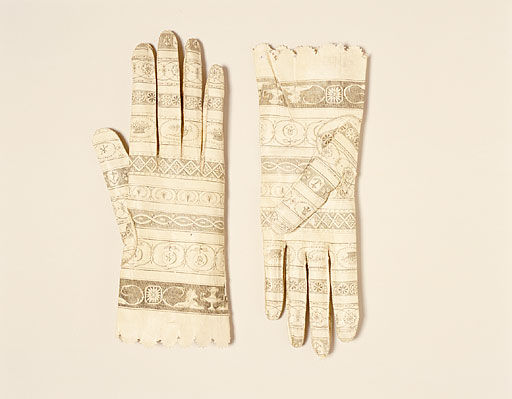gloves
Summary
White kid printed with horizontal bands of pattern in black, incorporating stylised motifs of flowers, cornucopias, anchors and couchant lions. Right hand glove stamped inside : "Felix / Torruella / Barcelona" From the Collection of Mariano Fortuny, Venice.
Display Label
Highly decorated gloves have been created and presented as gifts since the sixteenth century if not earlier. Sumptuously embroidered pairs for both men and women survive in substantial quantities from the seventeenth century, and reveal the skills of English needleworkers. Gauntlets covering the wrist section were extravagantly embroidered, trimmed with costly bobbin or needle lace, and with contrasting silk tabs as hinges, whilst the finger seams were overstitched. As slim elongated fingers were seen as a sign of beauty and gentility in Elizabethan times, glove makers strove to please their clients by cutting the finger sections far longer than a natural finger, with an extra "unfilled" section at the tip, as can be seen in these early examples. These elaborate, ornate accessories were not intended for wear, but for display and admiration, rather like the lavishly embroidered purses which contained coins or sweet herbs as gifts. Eighteenth century gloves were also highly trimmed, and some for women were elbow length. Kid can also be printed in bold monochrome designs as was popular in the early nineteenth century. The 1920s and 30s saw imaginative gauntlet designs based on "art deco" styles with contrasting bands of colour.
Object Name
gloves
Date Created
1800-10
Dimensions
Length: 21.25cm
accession number
1976.89
Collection Group
Place of creation
Barcelona
Medium
Legal
© Manchester Art Gallery

